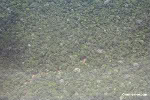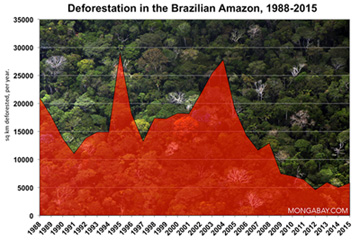Destruction of old-growth or primary forests looms large in discussions in Copenhagen over a scheme to compensate tropical countries for reducing emissions from deforestation and degradation (REDD). Some environmental groups are pressing for conservation of old-growth forests — the most carbon-dense, and biologically-rich state of forests — to be the centerpiece of REDD, while industry and other actors are pushing for “sustainable forest management” or logging using reduced-impact techniques to be the primary focus of REDD.
Central to the issue are concerns over biodiversity. Logged forests have been shown to be biologically impoverished relative to intact forests, but only temporarily in the case of selectively logged concessions, which under favorable conditions (i.e. reduced impact logging techniques, use of forest buffers, etc) can see a recovery of 70-80 percent of their biodiversity (among conspicuous plant and animal groups) within 30 years. Of course some primary forest specialists — species that cannot tolerate disturbance — lose out, likely heading towards extinction if at least some of their habitat is not preserved at the scale needed for their survival.

While Brazil ranks at the top most years in terms of tropical deforestation, the country has dramatically reduced forest loss on an annual basis since 2005. Since 2003 Brazil has set aside 523,592 square kilometers of protected areas, accounting for 74 percent of the total land area protected worldwide during that period. Photo by Rhett Butler.
|
But economics also come into play. Demand for wood products continues to raise and old-growth forests are often the main source of highly-coveted hardwoods. Highly selective logging — which may only target on or two trees per hectare — can have a limited impact on forest biodiversity and carbon sequestration, while generating a source of income for loggers, whether they be members of local communities or industrial timber companies. But logging also greatly boosts the likelihood that an area of forest will eventually be cleared, usually for agriculture or timber plantations. Logging usually involves road construction, which facilitates access to once remote areas and boosts development pressure.
So the debate over the use of old-growth forests encapsulates the much broader questions with addressing climate change. How much environmental degradation do we want to avoid and how much are we willing to spend to address environmental concerns?
Primary forest loss
The following section is a quantitative look at primary forest loss.
More than seven million hectares of primary forest were lost on an annual basis between 2000 and 2005, the most recent period for which data is available from the U.N. Food and Agriculture Organization. Roughly half this loss occurred in Brazil, which is home to the largest extent of tropical forest in the world: the Amazon.
But FAO figures don’t include destruction of primary forests in all countries. Notably excluded are Australia, Canada, Democratic Republic of Congo, India, and Venezuela; countries with substantial forestry industries that are logging large areas of old-growth forest (especially in the case of Australia, Canada, and Democratic Republic of Congo). These countries have not reported primary forest data since at least 1990.

Among countries that have reported primary forest cover, Brazil leads the pack, followed distantly by Indonesia, Peru, Colombia, and Mexico. In terms of rate of primary forest loss, two countries lost more than half their primary forest cover between 2000 and 2005: Nigeria (55.7 percent) and Vietnam (54.5 percent). Cambodia (29.4 percent), Sri Lanka (15.2 percent), Malawi (14.9 percent), Indonesia (12.9 percent), North Korea (9.3 percent), and Nepal (9.1 percent) followed.
But while primarily forests continue to fall, plantations forests are expanding, especially in North America, Europe and China. Plantations help offset the loss of natural forests in terms of carbon sequestration and as a source for wood products [i.e. “no net forest loss”], but contribute to an overall decline in global biodiversity as single species plantations replace their biologically richer natural counterparts. While most of this conversion is occurring in the tropics, Tasmania (Australia) and the American Southeast — where old-growth forests are being razed to establish pulp, paper, and timber plantations — buck the trend.
Forest Tables
All area figures are in hectares.

Worst deforestation rate of primary forests, 2000-2005. All countries.
| 1 | Nigeria | 55.7% | ||
| 2 | Viet Nam | 54.5% | ||
| 3 | Cambodia | 29.4% | ||
| 4 | Sri Lanka | 15.2% | ||
| 5 | Malawi | 14.9% | ||
| 6 | Indonesia | 12.9% | ||
| 7 | North Korea | 9.3% | ||
| 8 | Nepal | 9.1% | ||
| 9 | Panama | 6.7% | ||
| 10 | Guatemala | 6.4% | ||

Highest average annual deforestation of primary forests, 2000-2005, by area. All countries
| 1 | Brazil | -3,466,000 | ||
| 2 | Indonesia | -1,447,800 | ||
| 3 | Russian Federation | -532,200 | ||
| 4 | Mexico | -395,000 | ||
| 5 | Papua New Guinea | -250,200 | ||
| 6 | Peru | -224,600 | ||
| 7 | United States of America | -215,200 | ||
| 8 | Bolivia | -135,200 | ||
| 9 | Sudan | -117,807 | ||
| 10 | Nigeria | -82,000 | ||

Most primary forest cover, 2005. All countries
| 1 | Brazil | 415,890 | ||
| 2 | Russian Federation | 255,470 | ||
| 3 | Canada | 165,424 | ||
| 4 | United States of America | 104,182 | ||
| 5 | Peru | 61,065 | ||
| 6 | Colombia | 53,062 | ||
| 7 | Indonesia | 48,702 | ||
| 8 | Mexico | 32,850 | ||
| 9 | Bolivia | 29,360 | ||
| 10 | Papua New Guinea | 25,211 | ||
Most primary forest cover, 2005. Tropical countries
| 1 | Brazil | 415,890 | ||
| 2 | Peru | 61,065 | ||
| 3 | Colombia | 53,062 | ||
| 4 | Indonesia | 48,702 | ||
| 5 | Mexico | 32,850 | ||
| 6 | Bolivia | 29,360 | ||
| 7 | Papua New Guinea | 25,211 | ||
| 8 | Suriname | 14,214 | ||
| 9 | Sudan | 13,509 | ||
| 10 | Madagascar | 10,347 | ||
| 11 | Guyana | 9,314 | ||
| 12 | French Guiana | 7,701 | ||
| 13 | Congo | 7,464 | ||
| 14 | Thailand | 6,451 | ||
| 15 | Ecuador | 4,794 | ||
Related articles
E.U. pushes for logging in forest conservation program
(10/08/2009) Without safeguards to protect natural forests from conversion to plantations and industrial logging, REDD may fail to deliver promised reductions in emissions, warns a coalition of activist groups.
20% of land deforested in the Brazilian Amazon is regrowing forest
(09/06/2009) At least 20 percent land deforested in the Brazilian Amazon is regrowing forest, reports Brazil’s National Institute for Space Research (INPE).
Emissions from Amazon deforestation to rise as loggers move deeper into the rainforest
(07/31/2009) Emissions from Amazon deforestation are growing as developers move deeper into old-growth forest areas where carbon density is higher, report scientists writing in Geophysical Research Letters.
Are we on the brink of saving rainforests?

(07/22/2009) Until now saving rainforests seemed like an impossible mission. But the world is now warming to the idea that a proposed solution to help address climate change could offer a new way to unlock the value of forest without cutting it down.Deep in the Brazilian Amazon, members of the Surui tribe are developing a scheme that will reward them for protecting their rainforest home from encroachment by ranchers and illegal loggers. The project, initiated by the Surui themselves, will bring jobs as park guards and deliver health clinics, computers, and schools that will help youths retain traditional knowledge and cultural ties to the forest. Surprisingly, the states of California, Wisconsin and Illinois may finance the endeavor as part of their climate change mitigation programs.
A Tasmanian tragedy? : How the forestry industry has torn an island apart

(07/02/2009) This is by no means a new battle: in fact, Tasmanian industrial foresters and environmentalists have been fighting over the issue of clearcutting the island’s forests for decades. The battle—some would probably prefer ‘war’—is over nothing less than the future of Tasmania. Some Tasmanians see the rich forests that surround them in terms of income, dollars and cents; they see money literally growing on trees, or more appropriately growing on monoculture plantations and government owned native forests. They see the wilderness of Tasmania as an exploitative resource.

(06/09/2009) A global framework on climate change must immediately halt deforestation and industrial logging of the world’s old-growth forests, while protecting the rights of forest communities and indigenous groups, said a broad coalition of activist groups in a consensus statement issued today at U.N. climate talks in Bonn Germany. The statement said the successor treaty to the Kyoto Protocol should not include mechanisms that allow industrialized countries to “offset” their emissions by purchasing carbon credits from reducing deforestation in developing countries, a position that puts the coalition at odds with larger environmental groups who say a market-based approach with tradable credits is the only way to generate enough money fund forest protection on a global scale.
Forest degradation is huge source of CO2 emissions
(06/05/2009) Selective logging, understory fires, fuelwood harvesting, and other forms of forest degradation are a substantial source of greenhouse has emissions, reports a policy brief issued by The Nature Conservancy (TNC) at U.N. climate talks in Bonn, Germany.
Asia’s conversion of forests for industrial rubber plantations hurts the environment

(05/21/2009) Policies promoting industrial rubber plantations over traditional swidden, or slash-and-burn, agriculture across Southeast Asia may carry significant environmental consequences, including loss of biodiversity, reduction of carbon stocks, pollution and degradation of local water supplies, report researchers writing in Science. Conducting field work in the Xishuangbanna prefecture of China’s Yunnan province and assessing broader regional trends, Alan Ziegler of the National University of Singapore and colleagues argue that policies favoring agricultural intensification over small-scale slash-and-burn have encouraged the rapid expansion of rubber plantations across more than 500,000 hectares (1,930 square miles) of montane forest in China, Laos, Thailand, Vietnam, Cambodia, and Myanmar. Despite widespread perception among authorities that “swidden cultivation is a destructive system that leads only to forest loss and degradation”, the researchers found that the transition to industrial plantations has not necessarily been a boon to the environment.
Selective logging occurs in 28 percent of world’s rainforests

(01/13/2009) New satellite research presented for the first time at a symposium entitled “Will the rainforests survive?” showed that selective logging is impacting over a quarter of the world’s rainforests. Gregory Asner from the Carnegie Institution presented the “first true global estimate of selective logging” which showed that 5.5 million square kilometers of the rainforest has already seen selective logging or is slated to be logged in the near future.
Just how bad is the biodiversity extinction crisis?

(02/06/2007) In recent years, scientists have warned of a looming biodiversity extinction crisis, one that will rival or exceed the five historic mass extinctions that occurred millions of years ago. Unlike these past extinctions, which were variously the result of catastrophic climate change, extraterrestrial collisions, atmospheric poisoning, and hyperactive volcanism, the current extinction event is one of our own making, fueled mainly by habitat destruction and, to a lesser extent, over-exploitation of certain species. While few scientists doubt species extinction is occurring, the degree to which it will occur in the future has long been subject of debate in conservation literature. Looking solely at species loss resulting from tropical deforestation, some researchers have forecast extinction rates as high as 75 percent. Now a new paper, published in Biotropica, argues that the most dire of these projections may be overstated. Using models that show lower rates of forest loss based on slowing population growth and other factors, Joseph Wright from the Smithsonian Tropical Research Institute in Panama and Helene Muller-Landau from the University of Minnesota say that species loss may be more moderate than the commonly cited figures. While some scientists have criticized their work as “overly optimistic,” prominent biologists say that their research has ignited an important discussion and raises fundamental questions about future conservation priorities and research efforts. This could ultimately result in more effective strategies for conserving biological diversity, they say.















